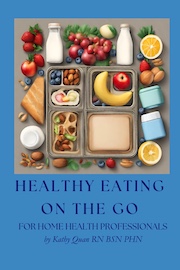More Medicare Fraud Being Punished
2023 Home Health Planner is Available NOW
The 2023 HomeHealth Planner is now available on Etsy. https://www.etsy.com/listing/1345548548/home-health-planner-2023. This is a Print Your Own planner. You purchase the .pdf files which are available for download as soon as your payment clears. This is usually within 5 minutes. You WILL NOT RECEIVE a physical product.
Open the .zip file and choose which .pdf pages you need to help keep you organized and managing your time effectively. Print as many copies as you need. Put into a 3-ring binder and PROTECT HIPAA info. Do not use any identifying patient names.
Some pages have some redundancy yes, but this is to help newbies adjust to the paperwork work flow, planning their day and making sure they have completed tasks. It also prompts reminders for next visit, keeping track of HHA supervisions, and keeping OASIS tasks on track.
Managing Exudate Improves Wound Care and Costs
This is a sponsored post written by me on behalf of ALLEVYN LIFE from Smith+Nephew. All opinions are 100% mine.
The general population is aging, and the oldest segment (those over 80) is one of the fastest growing. This segment is also demanding more and better health care to help them remain active, healthy, and fit. This comes at a cost and the cost of health care continues to skyrocket. The challenge for nurses and other healthcare professionals is to meet patient needs and somehow manage or reduce the costs.
Skin care is an increasing challenge as people age as well. The skin is the largest organ in the body and is therefore susceptible to a variety of challenges and issues. One such challenge is that as skin ages, it thins and can become quite fragile. It also dries out faster and requires more moisturizing to remain soft and supple. Fragile, dry skin can rip and tear easily from the lightest touch.
Skin break down or injury
If the skin is injured or breaks down from friction, pressure, or other means, it can become infected and, in some cases, even lead to sepsis. Prevention is a necessity and one that nurses focus on in all areas of health care. Treatment of wounds, bedsores, ulcers, surgical wounds, and other skin issues become a priority in patient care to prevent further break down, infection, or sepsis. Using products that simplify treatments help reduce pain and anxiety for patients and improve their experience of care.
Injured skin signals the body to release fluid and leukocytes to move quickly to the site of the injury in response to local inflammation. This substance is called exudate. There are four types of exudates known as serous, sanguineous, serosanguineous, and purulent. The exudate is essential to the healing process. The body’s inflammatory response leads to the dilatation of blood vessels with increased permeability. This then results in the increased production of exudate.
Exudate management
To best promote wound healing, the exudate needs to be managed. In a small wound, this is far less complicated. However, in larger wounds, ulcers, or bedsores, increasing amounts of exudate can cause complications such as maceration which can further break down the skin and result in a larger, deeper wound with a chance for worsening infection.
Larger wounds and bedsores often require highly exudative wound care. The exudate management is complex and can become quite costly if frequent dressing changes are required. The goal today is to manage and reduce the costs of health care. Frequent dressing changes can manage the exudate; however, exudate retention is a more cost-effective treatment. This also helps to reduce the burden on nurses in hospitals, clinics, and home health care. Patient satisfaction is increased because painful dressing changes are reduced, and wound healing is improved.
Over the years, many products have been brought to market to help promote exudate retention and wound healing. In my experience as a home health and hospice field nurse, I have tried them all. The most effective of these has been absorbent foam dressings which absorb and retain the exudate, protect and cushion the wound, and allow for increased healing.
The “Pink Foam Dressing”
One of these products, in my opinion, stands head and shoulders above the rest. Smith+Nephew's ALLEVYN LIFE Foam Dressing is the best. This is a silicone gel adhesive dressing with a super absorbent pad with a foam layer and lock away core. The outer layer is breathable and showerproof. It’s casually known as “the pink dressing” or the "pink foam dressing" based on its soft pink color. Don’t let the softness of the color deceive. This product is a workhorse.
Not only is this ALLEVYN product extremely absorbent, but it also comes in a variety of sizes and shapes to fit all those difficult places such as the coccyx or the bend of a knee or elbow. The exudate remains locked away in the core of the foam dressing and it adheres! The adhesion is gentle and releases easily, but it stays on until you remove or reposition it. Please see the Smith+Nephew website for full instructions for use and safety information.
Color change indicator
In addition, the outer edge of ALLEVYN dressing begins to change color as it absorbs the exudate signaling when the dressing is full or should be changed. Frequent monitoring should be done initially to determine how fast the dressing is absorbing the exudate as indicated by the change of color on the outer edge. This takes away the guessing game and the temptation to change the dressing more often than necessary. Consider changing the dressing when 50% of the color change is evident, but it can be left until 75% is color changed at the discretion of the nurse. How often the dressing should be checked should be reevaluated at each dressing change.
The ALLEVYN dressing is designed to remain in place up to 7 days (5 days in the sacral area) depending on the condition of the wound. As opposed to daily or BID dressing changes, this drastically reduces the cost of the product as well as the nurse’s time.
Should the exudate suddenly increase, the nurse will be able to note this on routine rounds, the patient can be taught to alert the nurse if the location is visible, or the CNA or home health aide can also check when bathing or assisting the patient and notify the nurse. This can greatly reduce the nurse’s time while allowing for improved wound healing. Of course, any new or increased symptoms such as redness, swelling, pain, discomfort, or odor emanating should be evaluated immediately.
View the color change indicator media on TheNursingSite.com
Media:
NOTE: This content, and any modification thereto, is owned in full by the creator engaged to provide services, and no rights or licenses of any kind are transferred. This content may not be used for commercial purposes, published, or distributed without the consent of the copyright owner.
Wound Care Improves with Exudate Management
This is a sponsored post written by me on behalf of ALLEVYN LIFE from Smith+Nephew. All opinions are 100% mine.
As a hospital nurse and then field nurse in home health care and hospice for years, wounds were always a big part of my daily patient care routine. As a nurse manager, I know this to be an ever-increasing part of the nurse’s role and function in a variety of health care settings.
Wound care has become very high tech and complex in growing attempts to improve quality of care and outcomes as well as the patient’s experience of care. The high cost of health care along with the aging population’s demand for more and better care continue to push for better supplies and equipment, in addition to treatments and techniques.
Managing exudate
One of the biggest challenges in wound care is managing the exudate. Exudate comes in four forms: serous, sanguineous, serosanguinous, and purulent. This is the body’s response to inflammation from injury whether accidental or planned. While exudate is necessary for healthy healing of wounds, too much can cause maceration and lead to infection and even sepsis. Drainage is uncomfortable for the patient and due to the sticky nature of blood and fluids, it can be very messy. Frequent dressing changes can be uncomfortable, inconvenient, and very costly for supplies as well as the nurse’s time.
If the exudate is managed and retained, the frequency of dressing changes can be extended even up to several days. This not only improves the cost-effectiveness and outcomes, but it also reduces the pain, inconvenience, and annoyance to the patient. In days past we would reinforce dressings to attempt to retain the exudate and extend the time between dressing changes. This becomes cumbersome and uncomfortable for the patient. It can also cause damage to the wound bed and slow healing. Layers upon layers of dressings also reduce the ability to visualize possible complications or to detect odor.
Foam Dressings
In my opinion, one of the best products on the market for years has been Smith+Nephew’s ALLEVYN LIFE Foam Dressing. Foam dressings have the ability to absorb and retain exudate better than other dressing products. They are soft and flexible and conform to the body better. The ALLEVYN LIFE Foam Dressing comes in a variety of sizes and shapes to fit and conform to the most difficult body parts to dress such as the coccyx or a bent knee or elbow. For specific information on the use and safety of ALLEVYN products, please refer to the Smith+Nephew website.
The “pink foam dressing” as it is casually known, works very well for all levels of exudative wound care involving wounds such as skin tears, bedsores, leg and foot ulcers, burns, and surgical wounds. ALLEVYN LIFE dressing is great for both exudate management and exudate retention including highly exudative wounds. It’s a silicone gel adhesive dressing with a foam layer and a lock away core made from super absorbent material. The silicone adhesion is gentle to fragile skin and allows for easy removal or repositioning. The breathable outer film layer provides protection from bacterial contamination and is showerproof. Keep in mind, while it is showerproof, the dressing should not be submerged in water.
Time to change indicator
The “pink one” also includes a change indicator that changes color as the exudate builds up in the lock away core. This indicates to the nurse when it’s time to change the dressing. This can be anywhere between 50% and 75% depending on the state of the wound and specific protocols. The dressing is designed to stay on up to 7 days (5 if used on the sacrum) but can vary depending on the amount of exudate in the wound. Other factors such as infection may play into the protocols. Fewer dressing changes have the advantage of advanced healing, improved quality outcomes, better patient experience of care, and improved cost-effective care.



